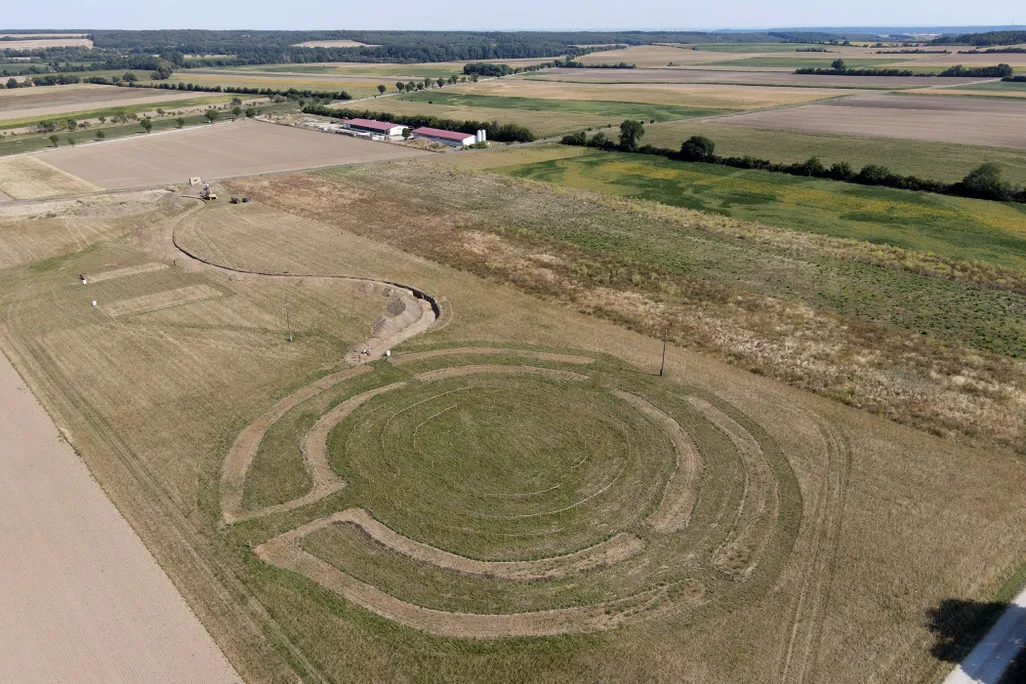Recent excavations have shed new light on the four circular ditches, which were identified in a field near Rechnitz, Austria, during surveys of the area between 2011 and 2017
/https://tf-cmsv2-smithsonianmag-media.s3.amazonaws.com/accounts/headshot/Sonja_headshot.png)
Sonja Anderson - Daily Correspondent
September 30, 2025

About 6,500 years ago, Neolithic groups dug several sets of concentric circles into a field in Austria. With time, grass grew to obscure the earthworks, which were unnoticed by subsequent inhabitants of the region for millennia.
But between 2011 and 2017, the circles were discovered during aerial and geomagnetic surveys of the area. Recently, archaeologists fully excavated the site, and their findings provide new insights into the region’s history.
/https://tf-cmsv2-smithsonianmag-media.s3.amazonaws.com/filer_public/8a/b9/8ab95793-ed74-4e93-99e8-be9101c510b8/2025-08_re_grabung_08.jpeg) Members of Burgenland Archaeology working at the excavation site
Burgenland Archaeology
Members of Burgenland Archaeology working at the excavation site
Burgenland Archaeology
“The excavations open a true window into the Stone Age,” Nikolaus Franz, director of Burgenland Archaeology, says in a statement, per a translation by La Brújula Verde’s Guillermo Carvajal. “We are learning a great deal about the clans of Neolithic settlers who found here a favorable place to establish the cultural techniques of farming and animal husbandry in what is now Austrian territory during the sixth millennium B.C.E.”
The circles lie near the town of Rechnitz in Burgenland, Austria’s easternmost state. According to the statement, archaeologists identified four ring-shaped monumental earthworks, the largest of which measures nearly 350 feet across. Three of them are circular ditch systems built between roughly 4850 and 4500 B.C.E. The ditches predate Stonehenge, the famous Neolithic monument in England, by some 2,000 years.
Quick fact: When was Stonehenge built?
The mysterious monument was constructed in many stages beginning roughly 5,000 years ago.
More than 120 of these ancient circular ditch systems have been found in Central Europe, per Burgenland Archaeology. They’re typically made of between one and five concentric circular trenches, which were often bordered by wooden stakes. The purpose of the earthworks remains mysterious.
The presence of three circular ditch systems in close proximity to each other makes the Rechnitz site unique, Franz says in the statement. He adds that Rechnitz was likely an important regional center during its heyday.
Researchers at the site also identified holes left behind by wooden posts, ceramic artifacts and the ruins of two nearby settlements. Some houses within these settlements date to a period known as the Neolithic Revolution, which began about 12,000 years ago. During this period of transition, hunter-gatherer groups gave up nomadic life in favor of agriculture. As National Geographic’s Erin Blakemore wrote in 2019, the shift “forever changed how humans live, eat and interact, paving the way for modern civilization.”
/https://tf-cmsv2-smithsonianmag-media.s3.amazonaws.com/filer_public/71/69/7169a1c3-2dc4-4c25-ac2f-971f3a15eb01/kreisgrabenanlage_rechnitz_kick-off_1.jpeg) Officials at the kickoff event for the recent excavations
Burgenland Archaeology
Officials at the kickoff event for the recent excavations
Burgenland Archaeology
Burgenland Archaeology is working on turning the Rechnitz site into an archaeological park with a visitors’ center. To enrich the experience, the team planted crops that mimicked the Stone Age inhabitants’ agricultural efforts, including barley, flax and nettle.
According to La Brújula Verde, the researchers’ goal is to “safeguard all the scientific information that lies underground before construction begins on the visitors’ center.”
Analysis of the Rechnitz site is ongoing. Soil samples were taken during the excavations, and researchers will be analyzing them at the University of Vienna. They hope to learn new details about the farming techniques and diets of the site’s inhabitants.
.png)



